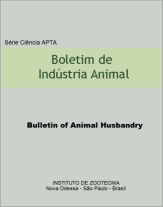Reproductive outcomes using different distances for preconditioning for the male effect in Anglo Nubian goats during two distinct climate seasons
DOI:
https://doi.org/10.17523/bia.v72n1p69Palabras clave:
bioestimulation, goat, small ruminantsResumen
The objective of the present study was to determine if separation distance between bucks and does during two distinct climate seasons could affect the reproductive performance of goats subjected to a 45-day mating season (MS). Anglo Nubian does (n = 120) were kept apart from bucks at distances of 2 m (T1), 300 m (T2), and 2000 m (T3) for 60 days prior to the 45-day MS during two distinct climate seasons [dry season (DS, February to March) and rainy season (RS, September to October)] in Sertânia, Pernambuco state, Brazil. There were no effects of distance of separation between bucks and does in any response variable evaluated. However, during the DS, the mean of the first estrous manifestation varied significantly (P>0.05) between groups [7.13±4.49 (T1), 8.84±5.64 (T2), and 6.37±4.21 (T3) days] and during the RS [7.33±5.74 (T1), 6.60±4.88 (T2) and 8.10±4.87 (T3) days]. Similar (P>0.05) estrous induction rates were found during both the DS [100.00% (T1), 100.00% (T2) and 95.50% (T3)] and the RS [100.00% (T1), 100.00% (T2) and 100.00% (T3)]. The estrous synchronization rate was found to be lower during the DS [36.60%; 30.00% (T1), 35.00% (T2) and 45.00% (T3)] than during the RS [56.60%; 50.00% (T1), 60.00% (T2) and 60.00% (T3)]. Pregnancy rates during the DS [P>0.05; 80.00% (T1), 70.00% (T2) and 75.00% (T3)] were lower than during the RS [P>0.05; 90.00% (T1), 90.00% (T2) and 95.00%(T3)]. In summary, the separation distance between bucks and does did not affect the reproductive outcome of Anglo Nubian goats over a 45-day MS under tropical conditions. Greater reproductive outcome was observed during the RS than the DS regardless of the separation distance between bucks and does.Descargas
Descargas
Publicado
Número
Sección
Licencia
Os autores não serão remunerados pela publicação de trabalhos, pois devem abrir mão de seus direitos autorais em favor deste periódico. Por outro lado, os autores ficam autorizados a publicar seus artigos, simultaneamente, em repositórios da instituição de sua origem, desde que citada a fonte da publicação original seja Boletim de Indústria Animal. A revista se reserva o direito de efetuar, nos originais, alterações de ordem normativa, ortográfica e gramatical, com vistas a manter o padrão culto da língua e a credibilidade do veículo. Respeitará, no entanto, o estilo de escrever dos autores. Alterações, correções ou sugestões de ordem conceitual serão encaminhadas aos autores, quando necessário. Nesses casos, os artigos, depois de adequados, deverão ser submetidos a nova apreciação. As opiniões emitidas pelos autores dos artigos são de sua exclusiva responsabilidade. Todo o conteúdo deste periódico, exceto onde está identificado, está licenciado sob a Licença Creative Commons Attribution (CC-BY-NC). A condição BY implica que os licenciados podem copiar, distribuir, exibir e executar a obra e fazer trabalhos derivados com base em que só se dão o autor ou licenciante os créditos na forma especificada por estes. A cláusula NC significa que os licenciados podem copiar, distribuir, exibir e executar a obra e fazer trabalhos derivados com base apenas para fins não comerciais.













